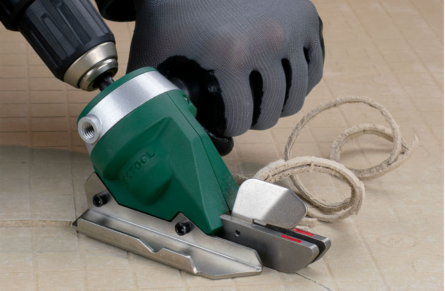
Different Ways to Cut Fiber Cement Backerboard

Using a backer board is crucial when laying down tile. Since tile is typically used in rooms with high moisture content (such as bathrooms and laundry rooms), a sturdy backer board is necessary in order to prevent mold, mildew growth, warped, irregular tiles and disintegration.
Though fairly cheap and readily available, fiber cement backer boards have a bit of a reputation for being hard to cut. Available in ¼’ and ½’ thicknesses, it can be difficult to find just the right tool to cut them. While there are different kinds of shears available, not all of them can make the kind of cuts necessary for installation. Here, we’ll list the pros and cons of each fiber cement cutting method.

A stationary shear is good for making 90-degree cuts. While they certainly get part of the job done, making the backer board smaller for whatever room it’s being placed in, it’s impossible for them to complete the project. A backer board needs to be completely adjusted before you lay down the tile. That means it must be curved around whatever furniture is in the room. If you go down the stationary shear route, you may end up spending much more money than expected, buying a bunch of other tools for curve cuts.

Though this method is cheap, simple, and minimizes dust, it’s rarely successful. Called the “score and snap” method, some people opt to cut partially through the backer board, pushing down on the part they want to cut and snapping it off. This method won’t work on a ½’ Hardie backer board, and while it canwork on a ¼’one, the edges will be ragged.

Another option is a circular saw. To cut through a fiber cement backer board, you can fit a circular saw with a specialized fiber cement blade. Yes, this option works, regardless of the backer board’s thickness. But should you use it? Well, it’s not the best option. While functional and cost-effective, circular saws tend to result in a lot of silica dust, which harms your lungs. So, if you go down this route, you’ll need to take a lot of extra precautions to protect yourself, like wearing a mask, cutting outdoors, and so on.

This tool is one of the better ones. It’s effective, and doesn’t produce as much silica dust as the circular saw. If you use a coarse blade, you should be able to get the job done. The only issue is that it isn’t made specifically for cutting fiber cement. So, while it certainly works, there are many adjustments you’ll have to make for it to work properly, like switching out the original blade for a coarser one.
Click the image above for a video on this product!
If you’re looking for an efficient, specialized fiber cement cutting tool, then Pactool’s SS724 Snapper Shear Pro is for you. Unlike stationary shears, which can only make 90-degree cuts, the Snapper Shear Pro can make straight, right angle, and curve cuts on ½’ and ¼’ backer boards. The edges are guaranteed to be clean, something that the “score and snap” method doesn’t promise. It’s also built for reducing silica dust, so you can cut indoors when necessary.
There’s no need to worry about being left-handed either; it adjusts for both right and left-handed users. What’s more, this tool fits onto any cordless drill (18 volts or higher is recommended), so there’s no added worry about a cord getting in the way.
Now that you’ve got all the info you need on different fiber cement cutting methods, you’re ready to make the purchase that’s right for you. While each method has some benefits, only one of these tools is specially made for the task at hand. The SS724 Snapper Shear Pro is ready to take on your fiber cement cutting needs.
About PacTool:
PacTool is known for leading products in the construction, renovation and remodeling segments. Their products include the Gecko Gauge, which holds fiber cement siding in place during installation and can reduce labor requirements by half; Snapper Shears, a collection of dust-free cutting tools; and the Roof Snake nail puller and shingle replacers. For more about the complete Pactool product line, visit pactool.us.
PacTool is part of General Tools, a recognized leader in the design and development of precision tools. With more than 1,200 products, including specific-purpose hand tools as well as precision measuring and inspection tools, General Tools remains committed to delivering exceptional customer service to professionals, DIYers and hobbyists around the world. For more about General Tools and its products, visit generaltools.com
← Previous Post Next Post →